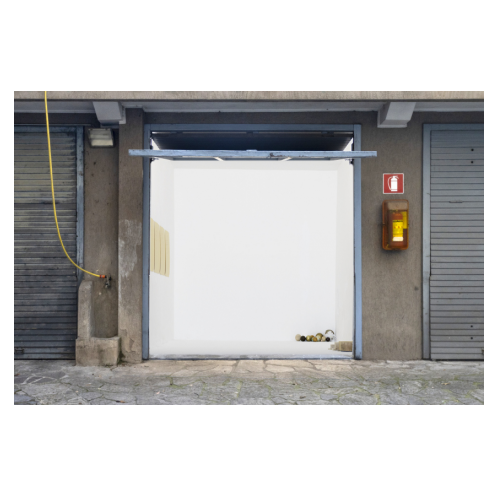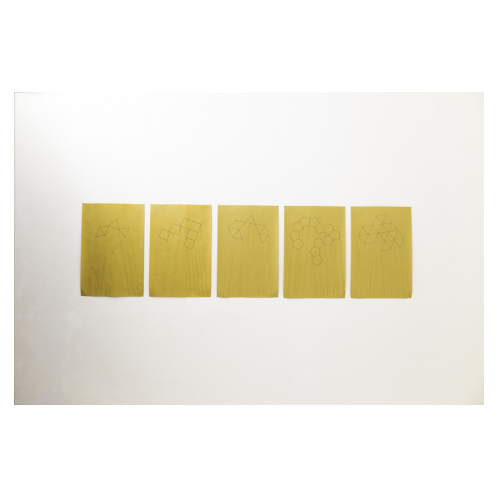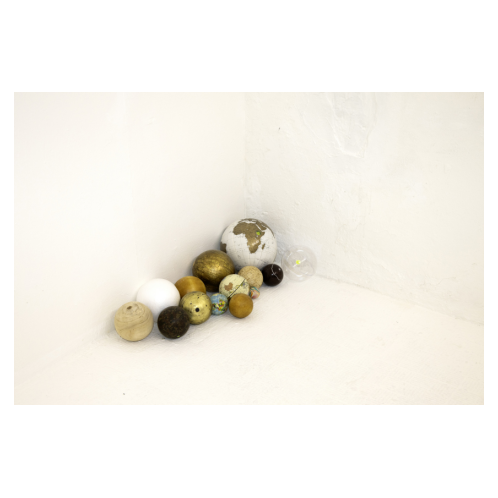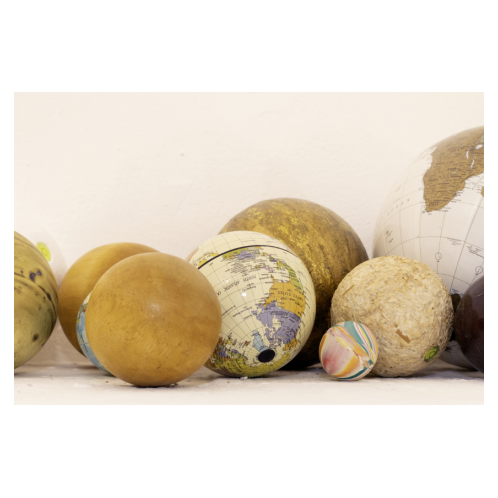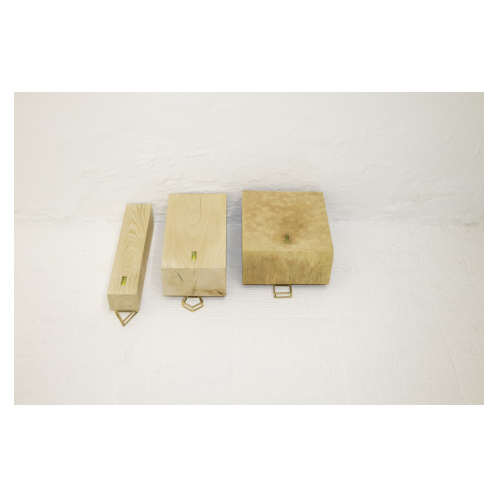Nazareno Guglielmi
Download Press Release in PDF Format ![]()
NAZZARENO GUGLIELMI
EQUILIBRIO PRECARIO
LA GEOMETRIA È CONCETTUALE
a cura di / curated by
GIORGIO VERZOTTI
INAUGURAZIONE
MERCOLEDÌ 22 NOVEMBRE 2023
ORE 18-21
dal 22 novembre al 30 dicembre 2023 solo su appuntamento
Sì, sono d’accordo, la geometria è concettuale. Non solo nel senso che è una cosa che nasce dall’attività mentale ma sopratutto nel senso che essendo legata alla mente ed essendo le menti molteplici, anche la geometria, anzi le geometrie, sono molteplici (cominciando a dividersi fra euclidee e non euclidee e così proseguendo). Quindi, relative, non assolute. Su un non-assoluto ci cimenta la mostra di Nazzareno Guglielmi (Fabriano, 1957) che oggi vediamo. Ciò che tutto relativizza è il tempo e l’artista, infatti, ci propone una riflessione sul tempo che, scorrendo, destabilizza; da qui anche il giusto richiamo, nel titolo. a un equilibrio instabile come legge che governa il tutto. Il tutto, quindi a maggior ragione le nostre stesse vite.
Di solito il connubio fra i concetti di arte e tempo porta all’idea di Kairos, il tempo fulmineo dell’ispirazione che dà origine all’opera e con essa a una visione del mondo. Guglielmi, invece, ci fa pensare per prima cosa a Kronos, il tempo ben più dimesso della cronologia, se vogliamo enfatizzare si può pensare al grigiore del “si vive” heideggeriano; eccolo emblematizzato in Triade Oro (2023), nome altisonante, ma collocazione antieroica: a terra. Tre parallelepipedi di diverso formato fatti di tre legni diversi con la parte inferiore smussata e stanno in piano grazie ai supporti che li reggono. Tre elementi in metallo dorato nelle forme del triangolo, del quadrato e del pentagono provvedono a rimettere i solidi in piano e lo testimonia la fiala da livella inserita in ciascuno di essi. Il legno di cui son fatti non è scelto a caso perché è una materia che ha addosso il tempo, si potrebbe dire: restano leggibili gli anelli che segnano gli anni di crescita dell’albero, e alcuni degli elementi che qui vediamo mostrano le fenditure che occorrono al legno quando è ancora giovane. Essi hanno anche un nome, che fa un po’ da sottotitolo, ed è il nome delle tre Moire che, nella mitologia greca, decretano la nascita, la durata della vita e il momento della morte degli esseri umani, tessendo e tagliando il filo di lana.
Triangolo, quadrato e pentagono sono le forme su cui si costruiscono i solidi platonici, quelli che nel Timeo sono definite forme primigenie e associate ai quattro elementi vitali: terra fuoco acqua aria. Sono quattro, il quinto, il dodecaedro, simboleggia e racchiude l’Universo. Nazzareno Guglielmi li decostruisce, li sviluppa sulla bi-dimensione, e li associa a immagini di aquiloni, che vediamo disegnarti su fogli liberi applicati alla parete dello spazio, unico elemento volatile, giocato in altezza, della mostra.
Volatile anche perché le cinque immagini sono associate al nome di altrettante farfalle, viventi ciascuna in uno dei cinque continenti, e viventi per un tempo breve, a volte un solo giorno, un tempo radicalmente opposto all’ipotesi di eternità che Platone contemplava.
Ecco un modo poetico ed anche formalmente elegante di rovesciare l’assoluto nell’estremamente relativo, tematizzando nel contempo la volatilità, la precarietà come statuto ontologico di ogni cosa.
Di nuovo a terra vediamo un gruppo di sfere, fatte dei materiali più diversi, stazionare in un angolo dello spazio. Ognuna di esse reca un’altra piccola livella circolare, fatto che evidentemente rasenta la contraddizione logica: affinché la livella inserita in una sfera resti “in bolla” occorre che la sfera stia immobile nella giusta posizione, il che può avvenire solo con un atto umano di volontà, a meno di confidare in un miracolo, un tempo istantaneo e massimamente imprevedibile in cui l’oggetto raggiunga per conto suo questa stasi. Il titolo dell’opera Meno di un attimo (2023) fa sorgere un dubbio: che sia questo il Kairos, il tempo imprendibile della rivelazione che nobilita il pensiero, l’azione, l’esistenza stessa?
Se è questo, l’artista lo chiama in causa con una notevole dose di ironia, assumendolo come possibile solo nell’istanza del paradosso.
Didascalie: Triade Oro, 2023, blocchi di legni diversi, fiale di livelle, metallo dorato, misure variabili; Aquiloni, 2023, matita su carta da spolvero, 75 × 50 cm cad.; Meno di un attimo, 2023, sfere di materiali diversi, fiale di livelle, misure variabili.
THE OPEN BOX
Via G.B. Pergolesi 6
MILANO
www.theopenbox.org
info.theopenbox.org@gmail.com
+393382632596
NAZZARENO GUGLIELMI
EQUILIBRIO PRECARIO
LA GEOMETRIA È CONCETTUALE
a cura di / curated by
GIORGIO VERZOTTI
OPENING
WEDNESDAY 22 NOVEMBER 2023
6-9 PM
from 22 November to 30 December 2023 by appointment only
Yes, I agree, geometry is conceptual. Not only in the sense that it is something that derives from mental activity, but above all in the sense that as it bound up with the mind and as the minds are multiple, geometry too, or rather geometries, are multiple (beginning with the division between Euclidean and non-Euclidean and so on). Relative therefore, not absolute. The exhibition by Nazzareno Guglielmi (Fabriano, 1957) we see today contends with a non-absolute. What relativizes everything is time and in fact the artist offers us a reflection on time that destabilizes as it passes, hence the appropriate reference in the title to a precarious equilibrium as a law that governs everything. Everything, and consequently our very lives too.
Generally, the bond between the concepts of art and time leads to the idea of Kairos, the lightning fast time of the inspiration behind the work of art and with it a vision of the world. Guglielmi, instead, makes us think firstly of Kronos, the far more relaxed time of chronology, should we want to emphasize, we might think of the dreary grey of the Heidegger-esque “one lives”; we find it in emblematic form in Triade Oro (Gold Triad, 2023), a lofty name, but an anti-heroic collocation on the floor. The lower parts of three parallelepipeds of differing formats made of three different woods have been chamfered meaning they only stay flat thanks to the supports holding them. Three elements in gilded metal in the form of a triangle, a square and a pentagon ensure the solids are set straight, as testified by the spirit level inserted in each of them. The wood from which they are made has not been chosen casually as this is a material that, it might be said, embodies time: the rings marking the tree’s years of growth remain legible and some of the elements that we see show the fissures that happen to wood when it is still young. They also have a name, which is something of a subtitle, the name of the three Moirai which, in Greek mythology, decree the birth, the duration of the life and the moment of the death of human beings, spinning and cutting a woollen thread.
The triangle, square and pentagon are the shapes on which the Platonic solids are based, those which in the Timaeus are defined as primigenial and associated with the four vital elements: earth, fire, water and air. They are four, while the fifth, the dodecahedron, symbolises and encloses the Universe. Nazzareno Guglielmi deconstructs them, unfolds them in two dimensions and associates them with images of kites, which we see drawn on sheets of paper, freely attached to the walls of the space, the exhibition’s single volatile, vertically configured element.
Volatile in part because the five images are associated with the names of five butterflies, each living on one of the five continents, and living for a brief space of time, perhaps a single day, a time radically opposed to the hypothesis of eternity contemplated by Plato.
Here we have a poetic and formally elegant way of reversing the absolute into the extremely relative, while introducing the theme of volatility, of precariousness as an ontological status of every single thing.
On the floor again we see a group of spheres, made of the most diverse materials and set in a corner of the space. Each of them carries another small, circular spirit level, something which clearly verges on logical contradiction. For the level inserted in a sphere to remain “level”, the sphere has to be correctly positioned and immobile and this can only be achieved through an act of human will, unless we rely on a miracle, an utterly unpredictable and instantaneous moment in which the object attains this stasis by itself. The title of the work Meno di un attimo (Less than a moment, 2023) raises a doubt: might this be Kairos, the ineffable time of revelation that ennobles thought, action and our very existence?
If this is true, then the artist is calling it into question with a healthy dose of irony, taking it as possible only in the instance of paradox.
Captions: Triade Oro (Gold Triad), 2023, blocks of various woods, spirit levels, gilded metal, variable dimensions; Aquiloni (Kites), 2023, pencil on sketching paper, each 75 × 50 cm; Meno di un attimo (Less than a moment), 2023, spheres of various materials, spirit levels, variable dimensions.
THE OPEN BOX
Via G.B. Pergolesi 6
20124
MILANO
www.theopenbox.org
info.theopenbox.org@gmail.com
+393382632596

